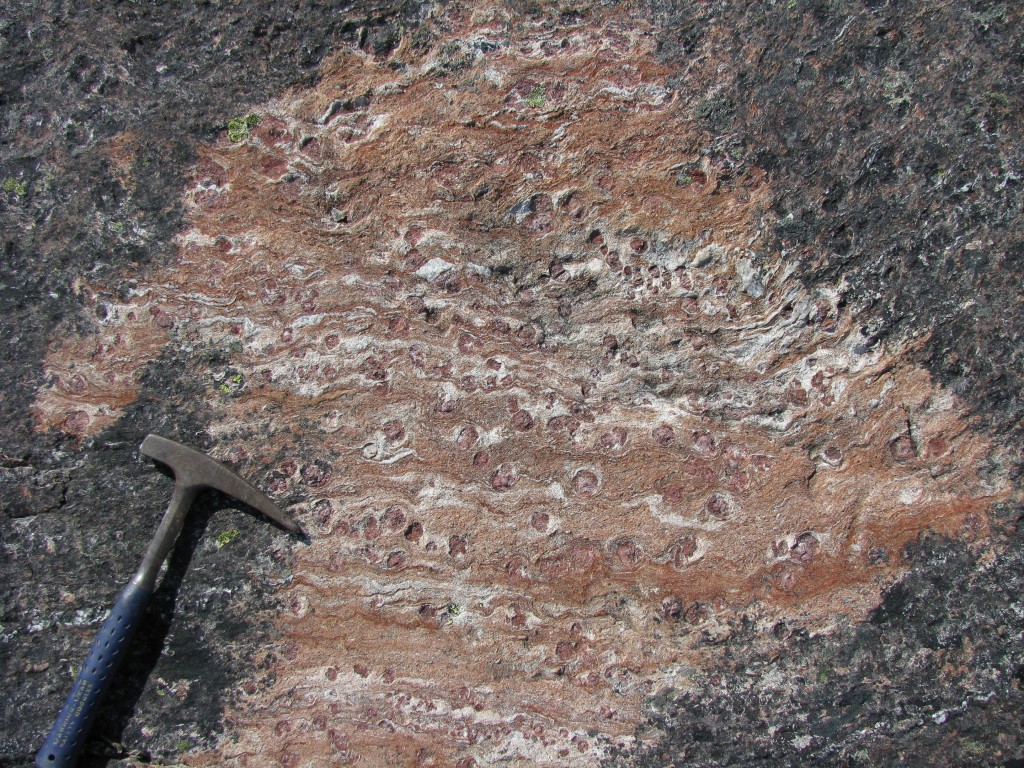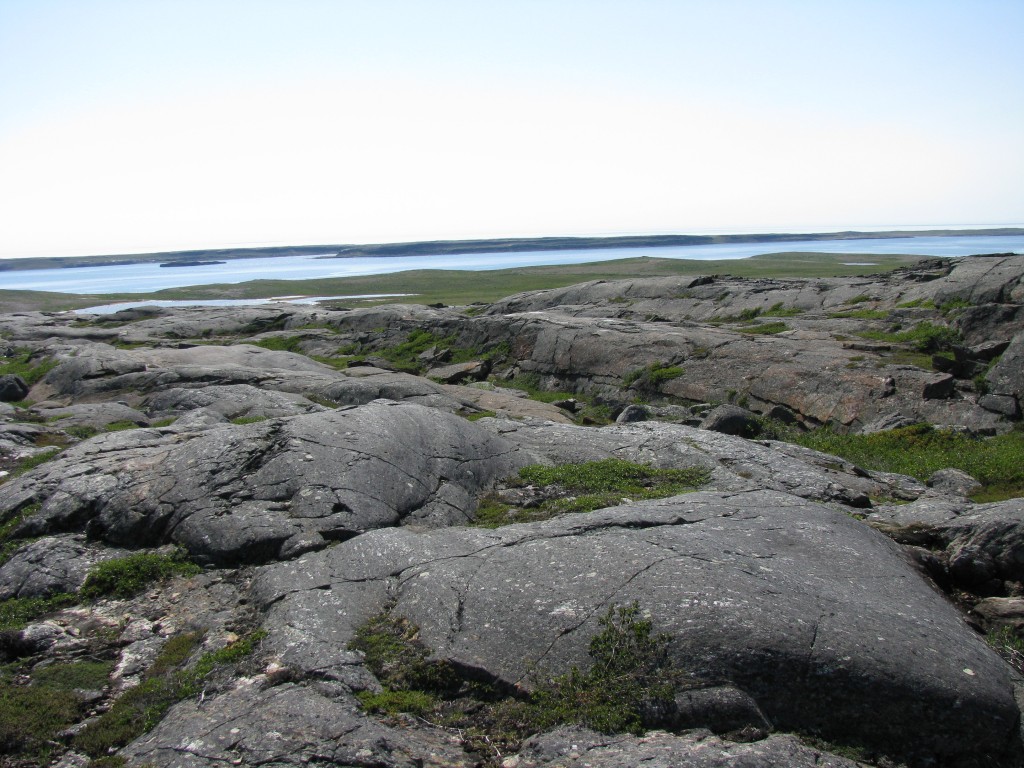 “It’s not your usual rock that you would find,” says Jonathan O’Neil, a geologist at the Carnegie Institution in Washington DC. It’s a bit of an understatement because O’Neil is referring to what he believes is the world’s oldest rock, a funny-looking basalt embedded in the Nuvvuagittuq greenstone belt in northern Quebec. The rock itself is brown and speckled with pink garnet dots. But there O’Neil runs into a problem.
“It’s not your usual rock that you would find,” says Jonathan O’Neil, a geologist at the Carnegie Institution in Washington DC. It’s a bit of an understatement because O’Neil is referring to what he believes is the world’s oldest rock, a funny-looking basalt embedded in the Nuvvuagittuq greenstone belt in northern Quebec. The rock itself is brown and speckled with pink garnet dots. But there O’Neil runs into a problem.
Dating methods for really old rocks (say the 3.8 billion year old variety) use relative geochronology, which involves dating Rock A using Rock B. Usually, the dating rock, the timekeeper rock, is zircon. “If you’re studying zircon you’re studying a second hand rock, you’re studying something from the melting of an older rock,” O’Neil explains. But what if, like O’Neil’s, your rocks don’t all contain zircon. Then what do you do?
Well, you innovate and you push the envelope and employ a dating method used only on meteorites and lunar rocks to date terrestrial rocks. “The geochronology tool we used requires the rock to be older than 4 billion years old,” he says, which helps explain why it’s never been done on terrestrial rocks before. Quite simply, there hasn’t been the need nor anything old-enough before.
If O’Neil’s dating technique is legit, then his rocks are 4.3 billion years old, meaning that they formed within 200 million years of our planet being no more than a big ball of molten magma (quite literally: “the earth probably was a big ball of fire” he says).
 Before we go any further, a quick run-through of the humbling timeline of Earth’s salad days. Our planet forms 4.5 billion years ago. It’s all bubbly, molten and hot. And just as it starts to cool down 4.4 billion years ago, wham, it’s hit with something big, really big. The impact remelts most of the Earth and the debris from this crash, well, there’s our moon. Shortly thereafter the moon-forming impact, say in the 100-150 million year window, the Earth cools down again, an ocean forms, and O’Neil’s rocks were created, pink speckles and all. At 4.3 billion years of age, O’Neil’s brown basalt ousts the previous contender, the 4.03 billion year old Acasta gneiss formation in Canada’s Northwest Territories, from the “Earth’s Oldest Rock” spotlight.
Before we go any further, a quick run-through of the humbling timeline of Earth’s salad days. Our planet forms 4.5 billion years ago. It’s all bubbly, molten and hot. And just as it starts to cool down 4.4 billion years ago, wham, it’s hit with something big, really big. The impact remelts most of the Earth and the debris from this crash, well, there’s our moon. Shortly thereafter the moon-forming impact, say in the 100-150 million year window, the Earth cools down again, an ocean forms, and O’Neil’s rocks were created, pink speckles and all. At 4.3 billion years of age, O’Neil’s brown basalt ousts the previous contender, the 4.03 billion year old Acasta gneiss formation in Canada’s Northwest Territories, from the “Earth’s Oldest Rock” spotlight.
In geology, it appears you can’t make a claim like that and get off scott free, and O’Neil most certainly has not. His research, which was published in 2008 in Science, has garnered headlines, criticism and skepticism in equal measure and he has been mired in defending his methods for the past three years. His dating method, while innovative, is equally unorthodox – problem number one. Problem number two, there are only a very few scientists who are experts in this method, which turned up a result “beyond what we knew”. And so his findings are a magnet for skeptics, who are trying to explain his data with complex models. O’Neil himself ascribes to Occam’s Razor: “The simplest explanation is that the rocks are nothing special, just normal rocks, but very old.”
On the phone, I ask him where his research stands today: what’s the update, the follow-up on the headlines of 2008 that heralded “Oldest Rocks on Earth Found”? You can almost imagine the big exhale that leaves his chest before he replies. “Most of my time has been spent defending our idea,” he says.
There he was, a PhD student who pitched a tent in in the Canadian shield for a month each field season. Under the northern sun he slung his sledgehammer at this funny brown and pink rock underfoot to collect his samples. Lo and behold, he had the good fortune to strike the Earth’s oldest rock. In his Science paper, O’Neil and his colleagues analyzed 10 rocks. Today that number is up to 85 as O’Neil hones and re-tests his methods, often recruiting other labs to reproduce his methods. He can keep at it for a while still seeing as he’s got some 500 fist-sized samples of on hand. “They’re just in the basement of my Washington lab,” he says, offhand.
Not for much longer. O’Neil is slated to return to Canada before continuing his research out of France for a year, after which he will move to Ottawa for a faculty position in 2012. He’s not quite sure how many he’ll ship to France. The rest he’ll drive up to Canada in the back of his moving truck. Let’s just hope his 500 rock samples don’t weigh him down too much.
_____________
Bio: Anne Casselman is a Vancouver-based science writer. She now has a new life’s ambition: to tour the world and hit up the five places on Earth where the rocks are older than 3.8 billion years.
Photo credits: Jonathan O’Neil
An alternative model for the origin and formation of granite-greenstone (and mantled gneiss domes) offers an explanation for the extreme age of the Nuvvuagittuq greenstone belt.
The alternative explanation suggests that the Nuvvuagittuq greenstone belt (and Belcher Islands) are part of the differentiated core of an outer-Oort-cloud comet that slammed into the Laurentide ice sheet 12,900 years ago in the Younger Dryas impact event (creating the Nastapoka Arc impact crater), and the 2 kilometer thick sheet of compressible ice in the Laurentide ice sheet absorbed enough of the kinetic energy to prevent resetting the isotope ratios used for (geo)chronology.
What has moved more since 2008 is the other end of the scale:
New dating (yes, including 146 Sm-142 Nd) makes it possible that the Earth-Moon impactor may be as young as 4.36 Ga bp.
Then the time window for making the Nuvvuagittuq rocks becomes (4 280 +53/-81) – 4 360 +/- 3) Ma or ~ 80 + 50/-80 = 0 – 130 million years window, if measuring errors in quadrature assuming independence. The average sounds about right.
@ David Carlson:
I don’t know if you were alluding to the post or not, but the alternative hypothesis fits the “trying to explain his data with complex models” to a tee. So thanks for illustrating the sheer steep cliff alternatives have to climb as opposed to the simplest of “a rock is just a rock” dating.